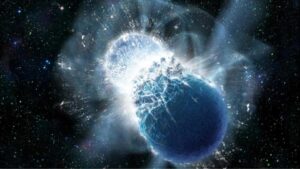
The most important factor about our Universe that we should be able to measure is its expansion rate. In 1929, Edwin Hubble provided the first observational evidence of an expanding universe when he demonstrated that galaxies that are further away, appear to be moving away faster than nearer galaxies.
This is a bit tricky to understand. Imagine you are in a gymnasium set up with a massive grid of desks. If the room is static, the desks all stay the same distance apart, and an observer doesn’t perceive them to be moving. If the gymnasium is expanding, you might notice that the spacing between any two neighboring desks grows 2 feet a minute. Looking around, after 2 minutes, the desks to your left and right, and front and back, all have moved 4 feet. A desk 2 desks away, will have moved 4 feet for the space between you and the first desk, and another 4 feet for the distance between the first desk and it. That means it moves a total of 8 feet in 2 minutes. The farther away the desk, the more space there is to expand, and the faster that distant desk will be carried by the universe’s expansion. If the gymnasium is big enough… bigger than is imaginable for a gym … the space that is expanding could be so vast that a distant desk appears to move as fast or faster than the speed of light. It isn’t actually moving that fast… it’s just caught up on an expanding surface, and all that space getting added in adds up to things moving away rather rapidly.
If the universe is moving apart at a constant rate, we should see a straight line in a plot of distance to an object… usually a galaxy rather than a desk… versus the velocity of the object. If the universe is expanding at a slowing or accelerating rate, we’ll see a curve in that plot.
The problem is, that while we can easily measure the apparent motions of galaxies, we can’t as easily measure their distance. Ideally, we need something to be shining brightly with a known amount of light. This allows us to compare how luminous we know they are with how bright they appear, and calculate their distance, the same way our brain automatically estimates distance by looking at how bright headlights appear.
Unfortunately, there aren’t a lot of extremely bright objects with known luminosities. To measure even moderately distant galaxies, we have just one tape measure: Type 1a supernovae. When these systems blow, they are expected to give off the same amount of light – on average – with every burst.
It isn’t entirely comfortable to only have one tool, however, and astronomers have been trying to find another tool for decades.
In a new paper in the journal Astronomy and Astrophysics, research led by Albert Sneppen shows that a pair of merging neutron stars have extremely symmetric explosions that have a luminosity related to the temperature of the explosion. No additional calibration is needed.
While these mergers – called kilonovae – are less frequent than supernovae, they can be seen at similar large distances and they should be frequent enough that within a few years, we’ll know if both methods give the same results. This will let us know if supernova explosions, which are calibrated using stars, are as accurate as we think, or if we need to rescale our understanding of the universe using these new data points. Whatever the result may be, it’s nice to know we have a clear path forward.
reference: Measuring the Hubble constant with kilonovae using the expanding photosphere method
Albert Sneppen, Darach Watson, Dovi Poznanski, Oliver Just, Andreas Bauswein and Radosław Wojtak
A&A, 678 (2023) A14 10.1051/0004-6361/202346306
